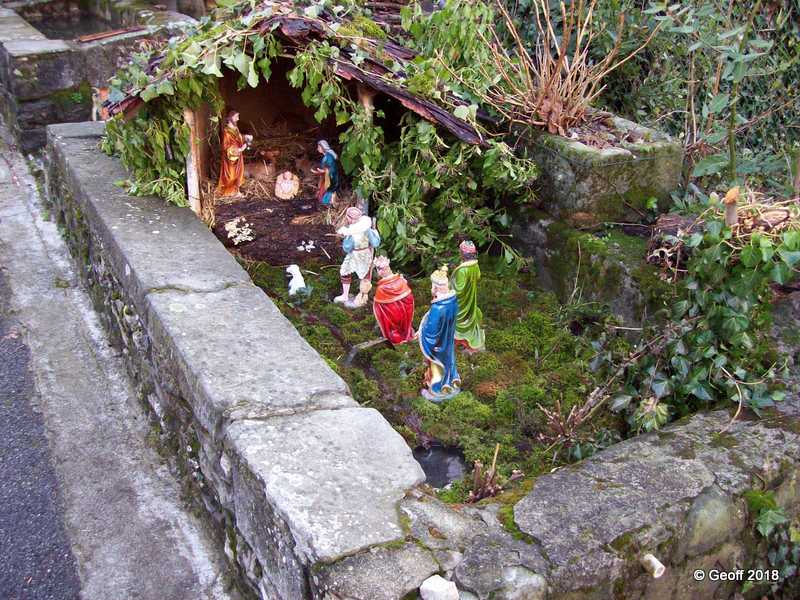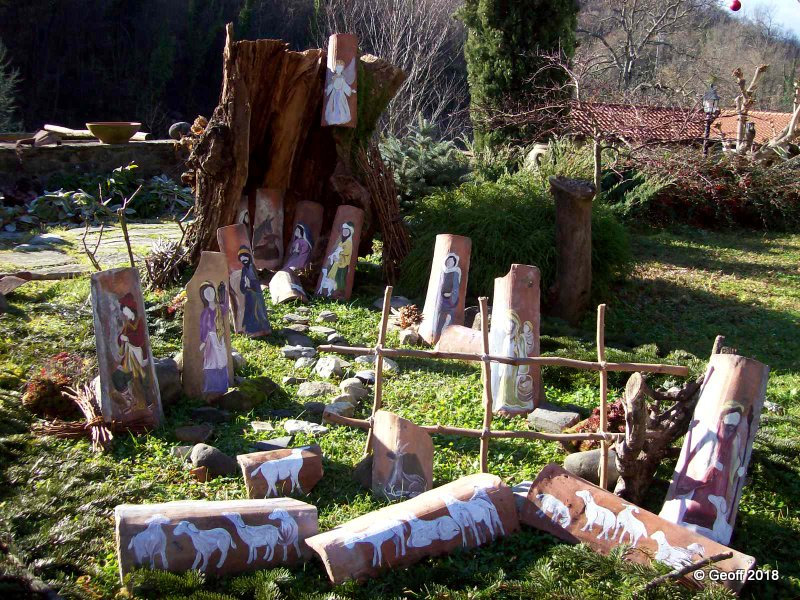The Moss Collectors Posted by Geoff on Dec 13, 2018 in Culture
Here in Italy at this time of year it’s common to see people removing clumps of moss from rocks or old stone walls and placing it in a basket.
When we were out walking a few days ago, for example, we spotted due suore (two nuns) in a field below us examining a terrace wall. “Cercate il muschio?” (are you looking for moss?) I called. “Sì, scusate” (yes, excuse us) she replied, probably assuming that it was our land. “Figuriamoci, qui ce n’è per tutti!” (don’t worry about it, there’s enough here for everyone!) I told her.
It’s true. This year, with the damp autumn that we’ve had, ‘di muschio ce n’è a volontà!‘ (there’s as much moss as you could want). The best place to find it (and if you were ever in the scouts you should know this) is on north facing surfaces. This is due to the fact that they are sheltered from the sun and therefore stay humid.
So, what’s all this moss gathering about, you may ask. Is it, perhaps, some old traditional winter dish, such as minestra di muschio (moss soup)? Well, moss is a fundamental ingredient, but not for a rustic recipe. It’s used in the construction of the home made presepe (nativity scene). Building one’s own presepe is a beautiful old tradition that is still very much alive in Italy. And in an age of mass produced cianfrusaglie di plastica (plastic knick-knacks) it’s truly heart-warming to see people’s enthusiasm for creating something original and unique out of natural materials.
Pieces of bark, pine cones, rocks, twigs, leaves, and the essential moss, are used to create a miniature landscape containing la stalla (the stable) and sometimes even the whole town of Bethlehem. Figurines of la Sacra Famiglia (the Holy Family), i pastori (the shepherds), i tre Re Magi (The Three Kings/Wise men) and so on, are placed in this setting to act out the Christmas story.
But what to do if there’s no moss available? Well, Serena grew up in North Africa, so she’s an expert on the matter. Over to you Serena:
Quando ero in seconda elementare, la maestra ci fece fare un piccolo presepe da portare a casa. Su una tavoletta quadrata di compensato costruimmo la stalla con le mollette da bucato in legno. Dentro alla stalla ci posizionammo le figurine di Maria, Giuseppe, il bue, l’asinello, e la culla con Gesù Bambino. Accanto alla stalla mettemmo anche una palma, fatta con del fildiferro e carta, se mi ricordo bene.
Prima di iniziare la costruzione del presepe, avevamo spalmato l’intera superficie della base di compensato con la colla, e poi ci avevamo sparso della sabbia (facilmente reperibile a Bengasi!). Il presepe era molto realistico con la sua palma e la sua sabbia. D’altronde Gesù era nato in Palestina, non in Europa, vero? Ma non andava bene per la maestra, abituata ai presepi italiani con il muschio. Così, per il tocco finale, spruzzò tutta la sabbia con vernice spray verde!
Here are a few more articles about il presepe (sometimes called il presepio):
Il Presepe Nel Lavatoio
La Tradizione del Presepe
An Italian Nativity
Have you seen any particularly memorable presepi? Let us know in the comments section.

Build vocabulary, practice pronunciation, and more with Transparent Language Online. Available anytime, anywhere, on any device.






Comments:
Jane Bowden:
Sono veramente bellissimi. Nonostante non sono una Cristiana, penso che quei presepi siano bellissimi. Li mostrerò ai miei amici inglesi.
Rosalind:
Mi piace la vernice spray verde sulla sabbia della Palestina, per fare più vero ?.
John:
I have seen various derivations of ‘figurare’ used in various contexts, and never knew what they meant. Now at last, I know that figuriamoci means ‘don’t worry about it’. Grazie. How about a blog about the uses and meanings of figurare?
Serena:
@John Salve John!
Sì, l’uso del verbo ‘figurarsi’ è molto comune nelle risposte, al posto di ‘prego’, ‘non c’è di che’, ‘non preoccuparti’ (non si preoccupi; non preoccupatevi).
Saluti da Serena